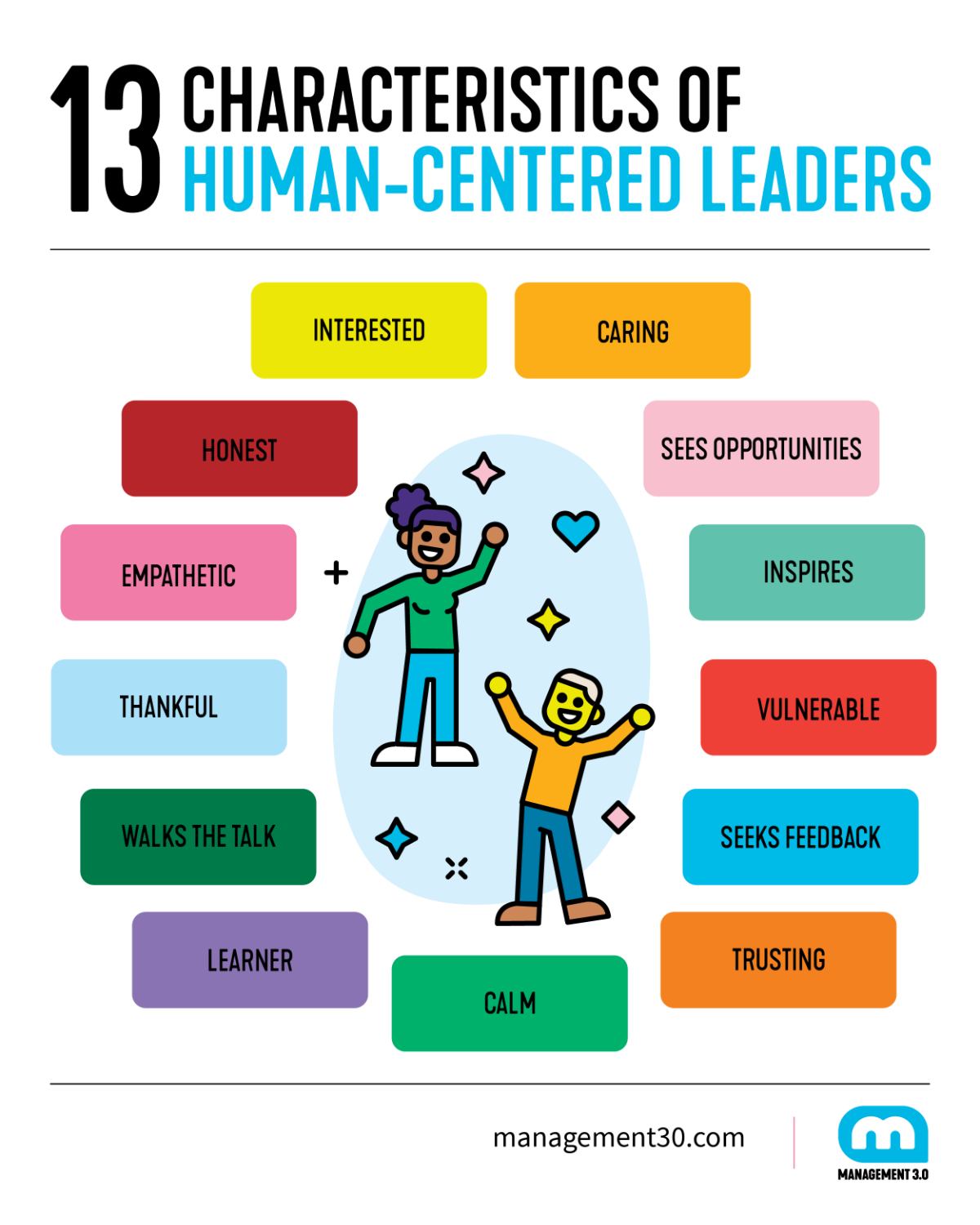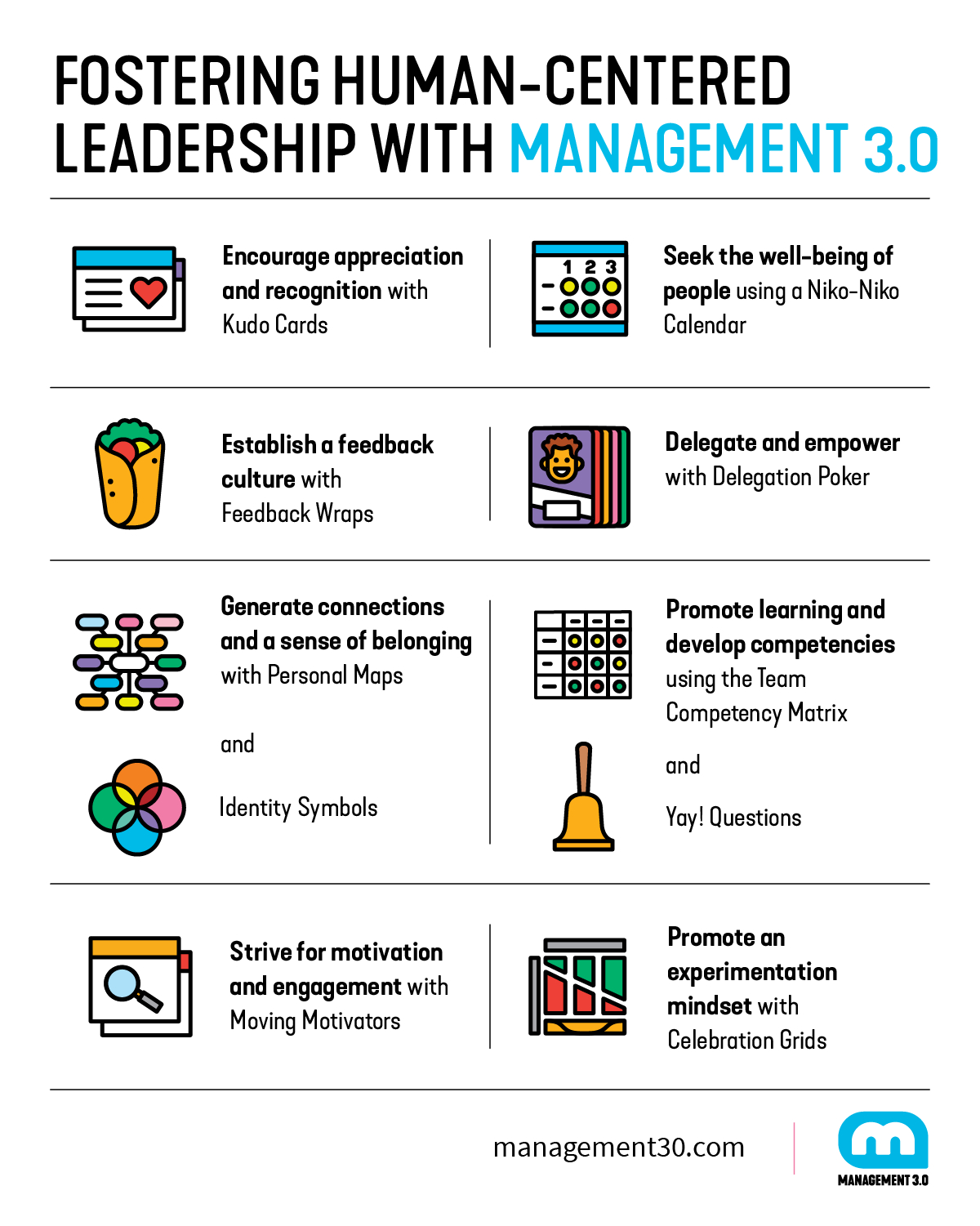Guillermo Lechuga, Management 3.0 Facilitator from Mexico, puts people first. He recently discovered this leadership style can be referred to as human-centered leadership. These are his thoughts about it:
I have always thought that being in charge of a team is a great responsibility…perhaps one of the greatest in my life. I remember when I started being a team leader I had a very human approach. Back then, peers and direct superiors criticized me for that.
They told me I should be harder on people because being “considerate” would only make them abuse my goodwill and make me look bad later on. At times I wondered if thinking of them as people, rather than employees, was the wrong approach.
Fortunately, the fun combined with good results made me realize my approach worked and was worth it. In time, I realized that I was not the only one using this leadership style. Some even call it “Human-centered leadership.”
What is human-centered leadership?
As the name says, human-centered leadership is a leadership style in which people are the priority. It’s about putting people first. For this, it is important to focus on aspects such as their motivation, state of mind, fears, social relationships, environment, and other things.
Leadership is not about being in charge, but about taking care of the people in your charge.
Simon Sinek
Leadership seeks to make things happen. Within human-centered leadership thinking one of the great challenges is to be aware that each person is unique and different, and that every day they are exposed to situations that can positively or negatively affect their motivation, state of mind and social relationships.
Why lead by centering on humans and putting people first?
Many people criticize the human-centered leadership approach, thinking that the important aspect for every organization is to generate results. Of course, results are important, but to reach those results it is important to look for your people.
Clients do not come first. Employees come first. If you take care of your employees, they will take care of the clients.
Richard Branson
In our VUCA world, organizations have to keep up and they need great talent to do so. Other companies might offer better salaries and benefits. But without human-centered leadership, those employees may suffer from a lack of commitment and motivation. This of course hinders organizations from achieving their goals.
What are the characteristics of a human-centered leader?
You are probably wondering how you can identify a human-centered leader, or even check if you are one. Therefore, I came up with a list of characteristics of human-centered leaders:
Human-centered leaders have a real interest in people
Human-centered leaders care about their team, about their personal and professional well-being. This concern must be genuine.
Human-centered leaders will seek to generate the conditions to promote a balance between these aspects no matter if there are goals related to this, a promotion, a bonus, or even a good story for a book; they will do it because they care about people.

Human-centered leaders are gardeners
Human-centered leaders look at each person as a flower: Each one is different, regardless of whether they are of the same species. Just like the gardener, they will seek to create an enabling environment so people can grow and develop, understanding that each has different interests, experiences, learning styles, and rhythms.
Human-centered leaders’ mission is to create a successful team with happy and competent people who generate results. Following the gardener analogy, they will achieve a beautiful garden, where all the flowers, despite being different, complement each other.
Human-centered leaders believe in people
Trust is essential to collaborate effectively. This is why human-centered leaders trust each person on their team, understanding that each one will do their best to achieve the desired results. Empowering people builds trust.
Also read: Collaborative Leadership
Human-centered leaders are vulnerable and honest
They show themselves as they are. Human-centered leaders are connected to their feelings and are capable of transmitting them to their team regardless of whether they are negative or positive. They understand they are human. Along these lines they seek to be honest with their feelings and the situations that occur on a day-to-day basis with their team members and colleagues.
Also read: The power of being vulnerable as a leader
Human-centered leaders have empathy
Of course, day-to-day, many setbacks happen, that’s the nature of life. Human-centered leaders don’t forget that their team consists of people with desires, dreams, problems, and fears. That is why for them it is important to connect with the other person and look at the situation through their eyes to have a better understanding.
According to Gartner, “CHROs need to provide managers with the proper tools to become human leaders and manage employees’ career perceptions, well-being and connection to organizational culture.”
Human-centered leaders see opportunities
Every time they encounter a problem, human-centered leaders transform it into an opportunity. They accept diversity, understand that people have different points of view, and seek psychological safety to address and resolve these situations without waiting for them to become bigger.
Human-centered leaders are lifelong learners
They understand that learning is constant, intentional, and strategic and that skills can be developed with effort and consistency (although some people may already have them).
Human-centered leaders teach how to fish
There is a phrase that I love that says, “Give a person a fish, and you feed them for a day. Teach a person to fish, and you feed them for a lifetime.” Human-centered leaders teach people to fend for themselves to promote their autonomy, knowing there is a place for everyone, and helping people shine with their light.
Human-centered leaders are feedback lovers
They are committed to continuous improvement, not only of their services or products but also with their leadership and the collaboration with your team. Human-centered leaders constantly ask for feedback to improve, as well as seek instances to be able to give constructive feedback that allows people to develop.

Human-centered leaders constantly thank and acknowledge
They know the importance of not only recognizing and thanking results but also good behaviors. Because human-centered leaders know it makes team members feel valued and that their work positively affects them, specifying where and for whom.
Human-centered leaders inspire instead of forcing
Through example, they inspire people to give their best and to choose to do the tasks that allow them to meet the objectives set, instead of being forced to do them by the imposition of the leader.
Human-centered leaders keep calm in uncertainty
Human-centered leaders understand that things can get out of control and seek to generate calm in people so that, with a calmer mind, they can think of options to help them reach their destination together.
Human-centered leaders act in congruence
Their intentions and the things they say are backed up by their actions.
Also read: Leading by example

Fostering Human-Centered Leadership
Does becoming a human-centered leader interest you? For me, the starting point to start developing and applying is caring about people.
Some tips to start the path on becoming a human-centered leader:
To become a human-centered leader, generate connections and a sense of belonging
As a starting point, it is important to make people feel that they are in a safe and trustworthy environment, surrounded by people with defects and virtues like them, with things in common and/or topics of interest. Generating connections between people is a good way to develop a relationship of trust.
➜ Management 3.0 Practice: Personal Maps
In the same way, we are social beings who like to feel part of something bigger, so it is important to generate a sense of belonging through the construction of an identity as a team. Why not define a name and a symbol together that represents them?
➜ Management 3.0 Practice: Identity Symbols
To become a human-centered leader, seek the well-being of people
People must be well, and therefore we need to know how they are feeling. In our busy work days it can become difficult to find space for this, especially in fast-paced environments or big teams. An idea to overcome this is to establish check-ins at the beginning of every meeting. Make the first agenda point a quick check in round in which everyone shares how they are feeling at this very moment.
Or you experiment with check-out at the end of the work day:
➜ Management 3.0 Practice: Niko-Niko Calendar



It was an honor for me to be considered by Guillermo Lechuga for the review of this article, where he reflects the knowledge, experience and his humanity in every word. Thank you for bringing leaders with another perspective to Latin America, I consider myself an advocate that the person prevails over the professional title.